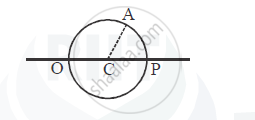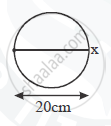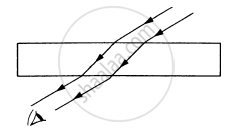Advertisements
Advertisements
प्रश्न
A point ‘O’ marked on the surface of a glass sphere of diameter 20 cm is viewed through glass from the position directly opposite to the point O. If the refractive index of the glass is 1.5, find the position of the image formed. Also, draw the ray diagram for the formation of the image.

उत्तर १
As we know that
u = - 20 cm
R = - 20 cm
n2 = 1.5
n1 = 1
Now by formula

`(n_2)/V - (n_1)/u = (n_2 - n_1)/R`
`1.5/V = -1/20 - 1/20`
`1/V = -1/(10xx1.5)`
V = -15 cm
उत्तर २
As we know that
u = - 20 cm
R = - 20 cm
n2 = 1.5
n1 = 1
Now by formula

`(n_2)/V - (n_1)/u = (n_2 - n_1)/R`
`1.5/V = -1/20 - 1/20`
`1/V = -1/(10xx1.5)`
V = -15 cm
APPEARS IN
संबंधित प्रश्न
Light of wavelength 5000 Å propagating in air gets partly reflected from the surface of water. How will the wavelengths and frequencies of the reflected and refracted light be affected?
Does the apparent depth of a tank of water change if viewed obliquely? If so, does the apparent depth increase or decrease?
A narrow beam of light passes through a slab obliquely and is then received by an eye following figure. The index of refraction of the material in the slab fluctuates slowly with time. How will it appear to the eye? The twinkling of stars has a similar explanation.

An object P is focussed by a microscope M. A glass slab of thickness 2.1 cm is introduced between P and M. If the refractive index of the slab is 1.5, by what distance should the microscope be shifted to focus the object again?
Choose the correct option.
There are different fish, monkeys, and water of the habitable planet of the star Proxima b. A fish swimming underwater feels that there is a monkey at 2.5 m on the top of a tree. The same monkey feels that the fish is 1.6 m below the water surface. Interestingly, height of the tree and the depth at which the fish is swimming are exactly same. Refractive index of that water must be
Write a short note on the prisms making use of total internal reflection.
What is Snell’s window?
A ray of light passes through equilateral prism such that the angle of incidence is equal to angle of emergence and each of these angles is equal to `(3/4)^"th"` the angle of prism. The angle of deviation is ______.
When a ray of light is incident normally on one refracting surface of an equilateral prism of refractive index 1.5, the emerging ray ______.
`[sin^-1(1/1.5)=41.8^circ]`
When a ray of light is refracted from one medium to another, then the wavelength changes from 6000Å to 4000Å. The critical angle for the interface will be ______.
